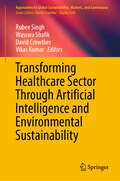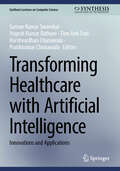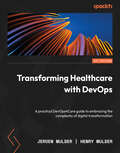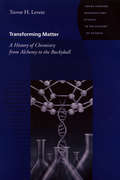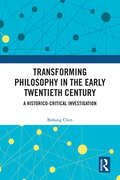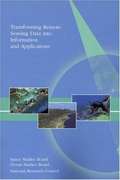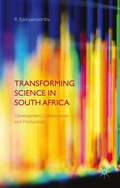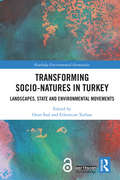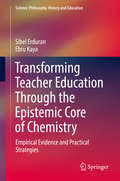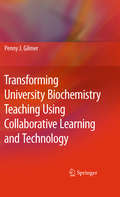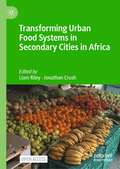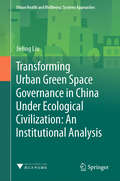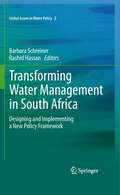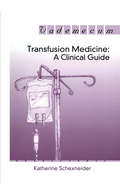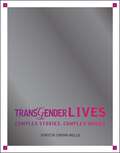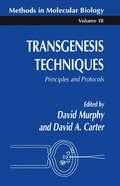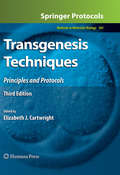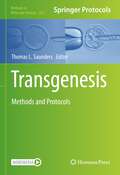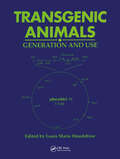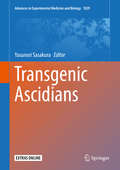- Table View
- List View
Transforming Healthcare Sector Through Artificial Intelligence and Environmental Sustainability (Approaches to Global Sustainability, Markets, and Governance)
by Vikas Kumar David Crowther Rubee Singh Wasswa ShafikThis book explores the intersection of artificial intelligence (AI) and sustainability in healthcare, focusing on how AI technologies are transforming medical practices while promoting environmentally responsible operations. It examines how AI-driven tools like machine learning and data analysis enhance diagnostic accuracy, streamline treatment planning, and personalize patient care by analysing large datasets, including genetic information. Additionally, the book addresses how AI can support sustainable healthcare practices by optimizing resource usage, such as energy consumption in hospitals, and improving supply chain management to reduce environmental impact. Practical case studies demonstrate how these technologies are being implemented to improve patient outcomes and achieve sustainability goals. The book considers the integration of AI into human resource management within healthcare, discussing AI's role in recruitment, performance management, and employee retention aligned with sustainability objectives. Ethical and regulatory issues surrounding AI adoption, such as data privacy and algorithmic transparency, are thoroughly examined, with an emphasis on creating responsible and equitable AI systems. Designed for healthcare professionals and administrators, this book provides practical strategies and real-world examples of AI implementation in sustainable healthcare, offering a balanced view of the opportunities and challenges ahead.
Transforming Healthcare with Artificial Intelligence: Innovations and Applications (Synthesis Lectures on Computer Science)
by Tien Anh Tran Suman Kumar Swarnkar Yogesh Kumar Rathore Harshvardhan Chunawala Pratikkumar ChunawalaThis book presents the groundbreaking ways artificial intelligence (AI) is revolutionizing the healthcare industry and delves into how AI technologies are enhancing patient care, improving diagnostic accuracy, and streamlining healthcare operations. With real-world examples of how AI is being used in hospitals, clinics, and research institutions around the world as well as insights from leading experts who provide readers with access to cutting-edge knowledge and diverse perspectives on the future of medicine, the book provides a comprehensive overview of the innovations driving the future of medicine. Healthcare is facing big challenges including the growing demand for medical services, the need for more accurate diagnoses, and the pressure to reduce costs. AI can help solve these problems by making healthcare more efficient, precise, and accessible to everyone. Appropriate for healthcare professionals, technology enthusiasts, or simply curious readers about the future of healthcare, this book offers a clear and engaging look at how AI is reshaping the medical landscape for the better. Specifically, the book covers various aspects of AI in healthcare, including diagnostics, treatment planning, patient monitoring, hospital management, and public health. In addition, the book presents the ethical, legal, and societal implications, providing a well-rounded discussion that considers both the opportunities and challenges of AI in healthcare.
Transforming Healthcare with DevOps: A practical DevOps4Care guide to embracing the complexity of digital transformation
by Jeroen Mulder Henry MulderLeverage modern technologies and agile methodologies such as DevOps and microenterprises to deliver sustainable healthcare solutions.Purchase of the print or kindle book includes a free eBook in the PDF format.Key FeaturesDistinguish the pace and time of change to achieve sustainable healthcareApply shared mental models for common understanding of healthcare challenges and how to overcome themApply and integrate new technology to accelerate the digital transformation of healthcareBook DescriptionHealthcare today faces a multitude of challenges, which can be summed up as the barriers architects and consultants face in transforming the healthcare system into a more sustainable one. This book helps you to guide that transformation step by step.You'll begin by understanding the need for this transformation, exploring related challenges, the possibilities of technology, and how human factors can be involved in digital transformation. The book will enable you to overcome inhibitions and plan various transformation steps using the Transformation into Sustainable Healthcare (TiSH) model and DevOps4Care. Next, you'll use the observe, orient, decide, and act (OODA) loop as an iterative approach to address all stakeholders and adapt swiftly when situations change. Further, you'll be able to build shared platforms that enable interaction between various stakeholders, including the technology-enabled care service teams. The final chapters will help you execute the transformation to sustainable healthcare using the knowledge you've gained while getting familiar with common pitfalls and learning how to avoid or mitigate them.By the end of this DevOps book, you will have an overview of the challenges, opportunities, and directions of solutions and be on your way toward starting the transformation into sustainable healthcare.What you will learnUnderstand the need for transformation of healthcareAccelerate transformation using the TiSH modelGet to grips with stepped, networked, and integrated careApply DevOps methodologies for healthcare in DevOps4CareFind out how to handle complexities through the system of systems thinkingBundle and unbundle organizations for the delivery of true patient-centric healthcareWho this book is forThis book is written specifically for enterprise architects and management consultants dealing with transformation in healthcare. Professionals dealing with digital transformation of healthcare, including C-level executives such as chief medical information officers (CMIOs), CEOs, CIOs, and CFOs will also find this book interesting. Basic knowledge of IT systems and architecture will help you grasp the concepts easily.
Transforming Matter: A History of Chemistry from Alchemy to the Buckyball (Johns Hopkins Introductory Studies in the History of Science)
by Trevor H. LevereChemistry explores the way atoms interact, the constitution of the stars, and the human genome. Knowledge of chemistry makes it possible for us to manufacture dyes and antibiotics, metallic alloys, and other materials that contribute to the necessities and luxuries of human life. In Transforming Matter, noted historian Trevor H. Levere emphasizes that understanding the history of these developments helps us to appreciate the achievements of generations of chemists.Levere examines the dynamic rise of chemistry from the study of alchemy in the seventeenth century to the development of organic and inorganic chemistry in the age of government-funded research and corporate giants. In the past two centuries, he points out, the number of known elements has quadrupled. And because of synthesis, chemistry has increasingly become a science that creates much of what it studies.Throughout the book, Levere follows a number of recurring themes: theories about the elements, the need for classification, the status of chemical science, and the relationship between practice and theory. He illustrates these themes by concentrating on some of chemistry's most influential and innovative practitioners. Transforming Matter provides an accessible and clearly written introduction to the history of chemistry, telling the story of how the discipline has developed over the years.
Transforming Philosophy in the Early Twentieth Century: A Historico-Critical Investigation
by Bohang ChenThis book conducts a historico-critical investigation into a proposal to transform philosophy in the early twentieth century.Driven by the Great Differentiation, the emancipation of the sciences from philosophy in the nineteenth century, several early twentieth-century philosophical movements advocated the transformation of philosophy from an endeavor to unify all conceivable human knowledge into a practice focused on the logical analysis of the differentiated sciences and broader human knowledge. However, this proposal was not subsequently adopted, leading to the establishment of academic philosophy as a discipline characterized by unique philosophical problems and solutions. Drawing on a variety of sources, this book posits that the transformation proposal offers crucial insights for understanding the history of philosophy, especially at its critical turning point in the early twentieth century. Moreover, although not pursued in academic philosophy today, this proposal still offers insights for rethinking the future role of philosophy. In response to Max Weber's fundamental challenge to philosophy post-Differentiation, it is argued that logical analysis offers a viable methodological approach and that the realm of values serves as a remaining substantive domain for practical philosophy.The book will be attractive to researchers and students interested in the history of philosophy and science as well as general intellectual history.
Transforming Remote Sensing Data into Information and Applications
by Steering Committee on Space Applications CommercializationThe National Academies Press (NAP)--publisher for the National Academies--publishes more than 200 books a year offering the most authoritative views, definitive information, and groundbreaking recommendations on a wide range of topics in science, engineering, and health. Our books are unique in that they are authored by the nation's leading experts in every scientific field.
Transforming Science in South Africa
by R. SooryamoorthyThis book is essential for anyone interested in knowing how science works nationally and internationally in the contemporary world. It offers a comprehensive analysis of scientific collaboration and its relation to development and the productivity of scientists, with specific reference to South Africa in both the past and the present.
Transforming Socio-Natures in Turkey: Landscapes, State and Environmental Movements (Routledge Environmental Humanities)
by Onur Inal Ethemcan TurhanThis book is an exploration of the environmental makings and contested historical trajectories of environmental change in Turkey. Despite the recent proliferation of studies on the political economy of environmental change and urban transformation, until now there has not been a sufficiently complete treatment of Turkey's troubled environments, which live on the edge both geographically (between Europe and Middle East) and politically (between democracy and totalitarianism). The contributors to Transforming Socio-Natures in Turkey use the toolbox of environmental humanities to explore the main political, cultural and historical factors relating to the country’s socio-environmental problems. This leads not only to a better grounding of some of the historical and contemporary debates on the environment in Turkey, but also a deeper understanding of the multiplicity of framings around more-than-human interactions in the country in a time of authoritarian populism. This book will be of interest not only to students of Turkey from a variety of social science and humanities disciplines but also contribute to the larger debates on environmental change and developmentalism in the context of a global populist turn.
Transforming Teacher Education Through the Epistemic Core of Chemistry: Empirical Evidence and Practical Strategies (Science: Philosophy, History and Education)
by Sibel Erduran Ebru KayaThis book synthesizes theoretical perspectives, empirical evidence and practical strategies for improving teacher education in chemistry. Many chemistry lessons involve mindless “cookbook” activities where students and teachers follow recipes, memorise formulae and recall facts without understanding how and why knowledge in chemistry works. Capitalising on traditionally disparate areas of research, the book investigates how to make chemistry education more meaningful for both students and teachers. It provides an example of how theory and practice in chemistry education can be bridged. It reflects on the nature of knowledge in chemistry by referring to theoretical perspectives from philosophy of chemistry. It draws on empirical evidence from research on teacher education, and illustrates concrete strategies and resources that can be used by teacher educators. The book describes the design and implementation of an innovative teacher education project to show the impact of an intervention on pre-service teachers. The book shows how, by making use of visual representations and analogies, the project makes some fairly abstract and complex ideas accessible to pre-service teachers.
Transforming Trauma: EMDR
by Laurel ParnellEye movement desensitization and reprocessing (EMDR#65533;) has helped thousands of clients haunted by abuse histories or recent traumatic events. It also benefits patients who have not found relief with other therapies and those with chronic conditions or blocked personal and professional performance. EMDR#65533; therapy incorporates eye movements into a comprehensive approach that processes and releases information trapped in the body-mind, freeing people from disturbing images and body sensations, debilitating emotions, and restrictive beliefs. Not only does healing occur much more rapidly than in traditional therapy, but clients also experience a sense of joy, openness, and deep connection with others. EMDR#65533; seems to be a quantum leap in the human ability to heal trauma and maladaptive beliefs.
Transforming U.S. Climate Change Policies: 2021 and Beyond (SpringerBriefs in Energy)
by Thomas L. BrewerThis book presents an integrated, multi-disciplinary analysis that combines climate science, economics, technology and political analysis of US climate policy changes undertaken during 2021. The book begins with an up-to-date discussion of the climate crisis as of 2021, with key concepts, problems and data all represented in straight-forward graphs and tables. This introduction to climate science and climate conditions establishes the context in which US climate policy is being made. The second chapter presents information about issues and policies at the advent of the Biden administration in January 2021 within the institutional context of the US political system. The chapter focuses on the initiatives taken by the new administration in a remarkable display of wide-ranging decision-making during its first year in office, and it also includes the policies of state and local governments. The third chapter offers a detailed analysis of the climate budget developed for the fiscal year 2022, a budget that marks dramatic increases in the amounts of funds for a wide variety of climate change programs—and also reductions in the subsidies for fossil fuel industries. A series of sectoral chapters examine the economics and technologies, as well as the government policies, in key industry sectors: energy, transportation, agriculture and finance. The final chapter is based on scenarios of future climate changes and policy paths that can address the mitigation and adaptation challenges of the next decade. The book offers specific information, so the reader can understand the contemporary climate issues and policies in the USA. At the same time, it provides the enduring concepts and fundamental features of the science, economics, technologies and political institutions that will shape the future.
Transforming University Biochemistry Teaching Using Collaborative Learning and Technology
by Penny J. GilmerOne aim of Gilmer's captivating text on university pedagogy is to show that biochemistry (or any science) does not consist solely of facts to be learned, but is a way of thinking about the world. Her purpose, both in this book and in her classroom, is to make her students into critical thinkers rather than passive learners. The chapters cast a critical eye over research into enhanced education techniques such as collaborative learning. Gilmer describes the action research she conducted in her own biochemistry undergraduate classroom into ways of improving the learning environment. She offers various perspectives on the make-up of her classroom, including an analysis of ethnographic data. The tools Gilmer employs as she hones her teaching skills include collaborative learning and technology. She views the classroom through various theoretical perspectives: social constructivism, cultural-historical activity theory, and a theory that involves the dialectic between the structure of the learning environment and the agency of the learners (a group among whom she includes herself). She provides a wealth of autobiographical detail as well as the results of her action research, which followed up on its original subjects after an interval of 11 years, to see what impact her course had on their professional growth. Above all, this volume is proof of what can be achieved in education when teachers are as interested in the process of learning as they are in their subject itself.
Transforming Urban Food Systems in Secondary Cities in Africa
by Jonathan Crush Liam RileyCountries across Africa are rapidly transitioning from rural to urban societies. The UN projects that 60% of people living in Africa will be in urban areas by 2050, with the urban population on the continent tripling over the next 50 years. The challenge of building inclusive and sustainable cities in the context of rapid urbanization is arguably the critical development issue of the 21st Century and creating food secure cities is key to promoting health, prosperity, equity, and ecological sustainability. The expansion of Africa’s urban population is taking place largely in secondary cities: these are broadly defined as cities with fewer than half a million people that are not national political or economic centres. The implications of secondary urbanization have recently been described by the Cities Alliance as “a real knowledge gap”, requiring much additional research not least because it poses new intellectual challenges for academic researchers and governance challenges for policy-makers. International researchers coming from multiple points of view including food studies, urban studies, and sustainability studies, are starting to heed the call for further research into the implications for food security of rapidly growing secondary cities in Africa. This book will combine this research and feature comparable case studies, intersecting trends, and shed light on broad concepts including governance, sustainability, health, economic development, and inclusivity. This is an open access book.
Transforming Urban Green Space Governance in China Under Ecological Civilization: An Institutional Analysis (Urban Health and Wellbeing)
by Franz Gatzweiler Jieling LiuThis book addresses the transdisciplinary subject of urban green space governance in Chinese cities through political sciences, organization theory, sociology, and new institutional economics lenses, with urban planning and ecology perspectives as research foundation and the science of climate change on health and wellbeing research background. It captivates readers by bringing answers to: 1) Why are urban green spaces such a highly contested subject in climate mitigation and adaptation, particularly in contexts like Chinese cities? 2) Why is it important to govern urban green spaces as common-pool resources? 3) How to design policies/institutions that can maximize the end objectives such as good health, wellbeing, and climate resilience? 4) What can ordinary citizens gain from caring more about greening their cities and contributing to the process? Besides, the methods used in this research-case-based study - qualitative in-depth interviews and qualitative content analysis using the mainstream qualitative data analysis software MaxQDA, are valuable learning sources, especially for junior graduate students. The book features three in-depth case studies with rich interview and illustration materials and a range of graphics of higher analytical quality. Readers both from research professionals to non-academics with a general cultural interest in geography would find this work instructive and informative.
Transforming Waste Management: Challenges and Success of an Indian City
by Mercy S Samuel Asad WarsiWaste management has become a great challenge for cities and urban areas, especially in countries with a high population density. This book looks at the waste management apparatus of the city of Indore, India, to see how the city overhauled its waste management practices and strategies to become one of the cleanest cities in the country.The volume highlights the challenges that the city faced and its use of innovative business models, technology, and infrastructure as well as instituting sweeping policy and process changes to bring change. It examines the city’s successful efforts to bring informal waste management systems to the mainstream and other interventions to close the gaps between government institutions, sanitation workers, and the general public. It further throws light on the use of technological interventions that the city government adopted for streamlining waste management and developing a sustainable business model for waste and emission reduction leading to achieve carbon credits and net zero goals.This book will be of interest to students, teachers, and researchers of urban planning and management, urban sociology, urban geography, waste management, and environmental studies. It will also be useful to policymakers and professionals working in the field of city management planning and governance.
Transforming Water Management in South Africa
by Rashid M. Hassan Barbara SchreinerOne of the early set of reforms that South Africa embarked on after emerging from apartheid was in the water sector, following a remarkable, consultative process. The policy and legal reforms were comprehensive and covered almost all aspects of water management including revolutionary changes in defining and allocating rights to water, radical reforms in water management and supply institutions, the introduction of the protection of environmental flows, and major shifts in charging for water use and in the provision of free basic water. Over ten years of implementation of these policy and legislative changes mean that valuable lessons have already been learned and useful experiences gained in the challenge of effective water resources management and water services provision in a middle income country.
Transfusion Medicine: A Clinical Guide
by Katherine I. SchexneiderTransfusion Medicine: A Clinical Guide is a concise, patient-focused handbook that guides physicians in the art of blood transfusion. The book begins with a clear explanation of the simple task of ordering blood, something many physicians have never learned. The next four chapters describe evidence-based transfusion for the common patient types acr
Transfusion: Blood and Sympathy in the Nineteenth-Century Literary Imagination
by Ann Louise Kibbie"England may with justice claim to be the native land of transfusion," wrote one European physician in 1877, acknowledging Great Britain’s crucial role in developing and promoting human-to-human transfusion as treatment for life-threatening blood loss. As news of this revolutionary medical technique spread from professional publications to popular journals and newspapers, the operation invaded the Victorian imagination. Transfusion is the first extended study of this intersection between medical and literary history. It examines the medical discourse that surrounded the real nineteenth-century practice of transfusion, which focused on women suffering from uterine hemorrhage, alongside literary works that exploited the operation’s sentimental, satirical, sensational, and gothic potentials.In the eighteenth century, the term "transfusion" was used to figure aesthetic and religious inspiration as well as erotic and romantic commingling—associations that persisted into the nineteenth century and informed attitudes toward the medical practice of blood transfer and the cultural conception of sympathetic exchange. Exploring transfusion’s role in canonical works such as Wells’s The Island of Dr. Moreau and Stoker’s Dracula, as well as a surprising array of lesser-known short stories and novels, Kibbie demonstrates the tangled, mutually informing relationship between science and culture. This innovative study traces the creation of a new fluid economy between persons, one that could be seen to forge new forms of intimacy between donors and recipients or to threaten the very idea of personal identity.
Transgender Lives: Complex Stories, Complex Voices
by Kirstin Cronn-Mills"I didn't hear the word transgender until I was eighteen, when a person I was dating came out as trans. My boyfriend came out as my girlfriend, and I thought, 'What . . . is that?' She said, 'I just don't think I'm a man.' And I said, 'Guess what? Neither do I.' And then the skies parted, and I understood who I was."—Katie Burgess, nonprofit director and community activist/organizer Meet Katie, Hayden, Dean, Brooke, David, Julia, and Natasha. Each is transgender, and in this book, they share their personal stories. Through their narratives, you'll get to know and love each person for their humor, intelligence, perseverance, and passion. You'll learn how they each came to better understand, accept, and express their gender identities, and you'll follow them through the sorrows and successes of their personal journeys. Transgender Lives helps you understand what it means to be transgender in America while learning more about transgender history, the broad spectrum of transgender identities, and the transition process. You'll explore the challenges transgender Americans face, including discrimination, prejudice, bullying and violence, unequal access to medical care, and limited legal protections. For transgender readers, these stories offer support and encouragement. Transgender Lives is a space for trans* voices to be heard and to express the complexities of gender while focusing on what it means to be human.
Transgenesis Techniques
by Alan R. ClarkeThis revised and updated edition of a much-acclaimed classic presents a collection of readily reproducible techniques for the generation and analysis of transgenic animals, with emphasis on the manipulation of the mammalian genome. It concentrates on the creation and maintenance of genetically modified murine strains, providing access to the germline by both conventional pronuclear injection, and by retroviral and adenoviral infection. Extensive coverage is also given to the generation, maintenance, and manipulation of embryonic stem cell lineages, with protocols for both constitutive and conditional (Cre-lox or the Flp-frt systems) gene targeting. Additional chapters provide cutting-edge techniques for the cryopreservation of both male and female germlines, for the generation of transgenic sheep by nuclear transfer, and for the basic analysis of transgenic organisms.
Transgenesis Techniques
by David Murphy David A. CarterPractical methods for the generation and analysis of transgenic animals, covering a comprehensive range of species, from invertebrates to lower vertebrates to higher vertebrates. Chapters examine ways in which transgenic techniques can be used to address many problems in biological systems present in-depth descriptions of analytical methods, and give step-by-step techniques that can be easily performed in your lab.
Transgenesis Techniques
by Elizabeth J. CartwrightOne of the major challenges currently facing the scientific community is to understand the function of the multitude of protein-coding genes that were revealed when the human genome was fully sequenced. In Transgenesis Techniques: Principles and Protocols, Third Edition, experts in the field fully update and expand upon the previous edition in order to detail the transgenic techniques currently used to modify the genome. The volume explores classic procedures to genetically modify mice and other model organisms, as well as cutting-edge practices involving microinjection, site-specific recombination systems, cryopreservation, and many other topics. Written in the highly successful Methods in Molecular BiologyTM series format, the chapters include brief introductions to their subjects, lists of the necessary materials and reagents, step-by-step, readily reproducible laboratory protocols, and notes sections, highlighting tips on troubleshooting and avoiding known pitfalls. Comprehensive and state-of-the-art, Transgenesis Techniques: Principles and Protocols, Third Edition is a comprehensive practical guide to the generation of transgenic animals and an invaluable source of information in any lab currently involved in transgenic techniques.
Transgenesis: Methods and Protocols (Methods in Molecular Biology #2631)
by Thomas L. SaundersThis detailed volume focuses on genotyping and validation in addition to information on how to produce gene edited cells and animals for research. Future advances in biomedical research will benefit greatly from the use of precise gene targeting of transgenes in the genome as CRISPR technology supersedes earlier methods that relied on random transgene integration, which this collection reflects. Written for the highly successful Methods in Molecular Biology series, chapters include introductions to their respective topics, lists of the necessary materials and reagents, step-by-step and readily reproducible laboratory protocols, as well as tips for troubleshooting and avoiding known pitfalls. Authoritative and practical, Transgenesis: Methods and Protocols serves as an ideal guide for researchers working with or working on genetically modified models.
Transgenic Animals
by Louis-Marie HoudebineDuring the past 20 years, transgenesis has become a popular technique and a crucial tool for molecular geneticists and biologists. Transgene expression is now better-controlled and even specifically inducible by exogenous factors. While these techniques have quite significantly transformed the experimental approaches taken by biologists, the applications are more limited than expected and concerns have arisen regarding biosafety as well as physiological, social, and philosophical issues. Transgenic Animals: Generation and Use contains articles on the techniques used to generate transgenic animals and a section on the preparation of vectors for the optimally controlled expression of transgenes. It also examines the use of transgenic animals in the study of gene function and human diseases, the preparation of recombinant proteins and organs for pharmaceutical and medical use, and the improvement of genetic characteristics of farm animals. Finally, it discusses more recent problems generated by transgenic animals including conservation of transgenic lines, specific database patenting, biosafety, and bioethics.Drawn from both academia and industry, the contributors to this monograph present in one concise volume all the relevant information on the different aspects of transgenesis. This book can be used as both a reference book and a textbook for specialized university courses and will be of interest to everyone involved in basic research in animal biology, molecular genetics, animal biotechnology, pharmaceutical science, and medicine.
Transgenic Ascidians (Advances In Experimental Medicine And Biology #1029)
by Yasunori SasakuraThis book comprehensively describes the transgenesis techniques and applied experimental methods in ascidians including enthusiastically developed original devices in addition to concrete examples of developmental biology studies. Ascidians have been one of the most important model animals in developmental biology for studying molecular and cellular processes underlying formation of the chordate body plan. Transgenic techniques such as microinjection, electropolation, cis-element analysis and application, and TALENs and CRISPR/Cas9 have been developed in ascidians for more than 20 years, and now many applied methods, some of which are unique in ascidians, have been accumulated. Those extensive technological innovations, such as cell isolation, cell labeling, germ-line transformation, marker transgenic lines, and the experimental systems for studying notochord formation and nervous system, are exceptional particularly in marine invertebrates. This book is useful for ascidian researchers to quickly access the techniques in which they are interested as well as to compare each technology to become familiar with specialized tips, and for biologists of other organisms to learn the unique techniques and ingenious attempts specific to ascidians. Providing detailed and easily understandable descriptions of techniques, the book will inspire ascidian specialists to improve their techniques, encourage anyone wanting to begin studying ascidians, and enable readers to immediately apply the techniques to the organisms they research.
